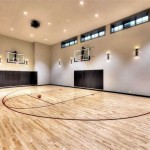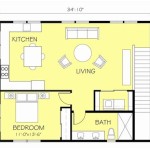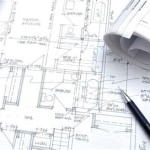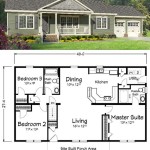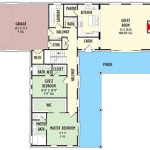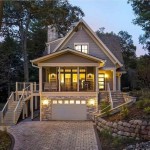House Plan of Two Bedroom Considerations and Design Elements
The house plan of two bedrooms represents a common and practical choice for individuals, couples, small families, or those seeking to downsize. These plans offer a balance between affordability, manageability, and sufficient living space. Careful consideration of design elements and spatial arrangement is paramount to maximizing functionality and comfort within the constraints of a two-bedroom footprint.
Developing an effective two-bedroom house plan involves a multifaceted approach, taking into account the intended occupants, their lifestyle, and any specific needs or preferences. Key aspects to address include the overall layout, room sizes, storage solutions, natural light integration, and accessibility considerations. The selection of appropriate materials and finishes further contributes to the overall aesthetic appeal and longevity of the dwelling.
Optimizing Space and Layout: Design Strategies
The layout of a two-bedroom house plan plays a crucial role in determining the flow and utilization of space. Open-concept living areas, where the living room, dining area, and kitchen are seamlessly integrated, are a popular choice for creating a sense of spaciousness. This design approach enhances social interaction and allows for greater flexibility in furniture arrangement.
Careful zoning within the open-concept space is essential to define distinct areas for various activities. This can be achieved through strategic furniture placement, changes in flooring materials, or the introduction of partial walls or dividers. Maintaining a clear circulation path throughout the house is also important to avoid congestion and ensure easy movement between rooms.
The placement of bedrooms should prioritize privacy and tranquility. Ideally, they should be located away from high-traffic areas like the entrance or living room. Orienting bedrooms towards the rear of the property can further mitigate noise from the street. Considerations for natural light and ventilation in the bedrooms are also critical for creating a comfortable and healthy sleeping environment.
The design should consider future adaptability. Incorporating flexible spaces that can serve multiple purposes, such as a home office that can be converted into a guest room, enhances the long-term value and usability of the house. Furthermore, planning for potential expansions or modifications, such as adding a deck or extending the living area, can accommodate future needs and lifestyle changes.
Storage Solutions: Maximizing Usable Space
Storage is often a significant challenge in smaller homes, making efficient storage solutions essential in a two-bedroom house plan. Integrating built-in storage, such as closets, shelves, and cabinets, throughout the house can significantly reduce clutter and maximize usable space. Strategic placement of storage areas in hallways, entryways, and under staircases can utilize often-overlooked spaces.
In bedrooms, walk-in closets, if space allows, provide ample storage for clothing, shoes, and accessories. Alternatively, well-designed reach-in closets with adjustable shelving and hanging rods can offer a practical storage solution. Utilizing vertical space by installing shelves that extend to the ceiling can further increase storage capacity.
The kitchen should be designed with ample cabinet space to accommodate cookware, utensils, and food storage. Consider incorporating features such as pull-out shelves, drawer organizers, and pantry cabinets to maximize efficiency and accessibility. In the living area, built-in shelving units can provide storage for books, media equipment, and decorative items.
Outdoor storage solutions, such as a shed or deck box, can be useful for storing gardening tools, outdoor furniture, and other seasonal items. Optimizing garage space, if available, with shelving and organizational systems can further enhance storage capacity. Thoughtful consideration of storage needs during the design phase can significantly improve the functionality and livability of a two-bedroom house.
Incorporating Natural Light and Ventilation: Enhancing Comfort and Well-Being
Natural light and ventilation play a vital role in creating a comfortable and healthy living environment. Maximizing natural light reduces the need for artificial lighting, saving energy and creating a more visually appealing space. Proper ventilation improves air quality and helps to regulate temperature, contributing to overall well-being.
Orienting the house to take advantage of solar gain can optimize natural light penetration. South-facing windows provide the most sunlight throughout the day, while east-facing windows capture morning light. Large windows and sliding glass doors can flood the living spaces with natural light, creating a brighter and more inviting atmosphere.
Skylights and clerestory windows can be used to bring natural light into areas that may not have direct access to exterior walls. These architectural features can also enhance ventilation by allowing warm air to escape from the upper levels of the house.
Proper ventilation is essential for maintaining good indoor air quality. Strategically placed windows and doors facilitate cross-ventilation, allowing fresh air to circulate throughout the house. Ceiling fans can also improve air circulation and reduce the need for air conditioning. In areas with high humidity, consider installing exhaust fans in bathrooms and kitchens to remove moisture and prevent mold growth. The selection of low-VOC (volatile organic compound) paints, sealants, and flooring materials can further improve indoor air quality.
Designing a two-bedroom house plan demands a thoughtful approach to spatial planning, storage solutions, and the incorporation of natural light and ventilation. The efficient use of space, coupled with attention to detail in material selection and finishes, can result in a dwelling that is both functional and aesthetically pleasing. Adherence to building codes and regulations is crucial to ensure the safety and structural integrity of the house. Consulting with an architect or experienced designer can provide valuable insights and guidance throughout the design process ensuring a residence that meets individual needs and preferences.
Consideration should be given to the target demographic for the two-bedroom house. For young professionals, the focus might be on a modern design with open-concept living and a home office. For retirees, accessibility features, single-story layouts, and low-maintenance materials may be more important. A family with young children might prioritize a child-friendly layout with easy access to outdoor play areas and durable, easy-to-clean finishes.
Landscaping plays a crucial role in enhancing the curb appeal and overall value of a two-bedroom house. Thoughtful landscaping can create a welcoming entrance, provide privacy, and reduce energy consumption by shading the house from direct sunlight. Selecting native plants that are well-suited to the local climate can minimize water usage and maintenance requirements.
The selection of appliances and fixtures should be based on energy efficiency and water conservation. Energy Star-rated appliances can significantly reduce energy consumption, lowering utility bills and minimizing environmental impact. Low-flow toilets, showerheads, and faucets can conserve water without compromising performance. LED lighting is another energy-efficient option that provides ample illumination while consuming significantly less electricity than traditional incandescent bulbs.
Universal design principles should be incorporated to ensure that the house is accessible to people of all ages and abilities. This includes features such as wider doorways, grab bars in bathrooms, and lever-style door handles. Designing the house with future accessibility in mind can make it easier to adapt to changing needs over time.
Durability and low maintenance are important considerations for long-term cost savings and reduced upkeep. Selecting durable materials, such as brick, stone, or fiber cement siding, can minimize the need for repairs and replacements. Choosing low-maintenance landscaping options can also reduce the time and effort required for yard work.

Small House Designs Shd 2024001 E5d

2 Bedroom Apartment House Plans

6 Stunning 2 Bedroom House Plan Make My

2 Bedroom House Plans For Stylish Homes Ck

Two Bedroom Small House Plan Cool Concepts

Unique Small House Plan Id12209 Floor Plans By Maramani

Practical 2 Bedroom House Plan With L Shaped Kitchen

Two Bedroom House Plans

Style G 2 Bed Village At Fox River

2 Bhk House Plan For Your Dream Home Construction Jk Cement

